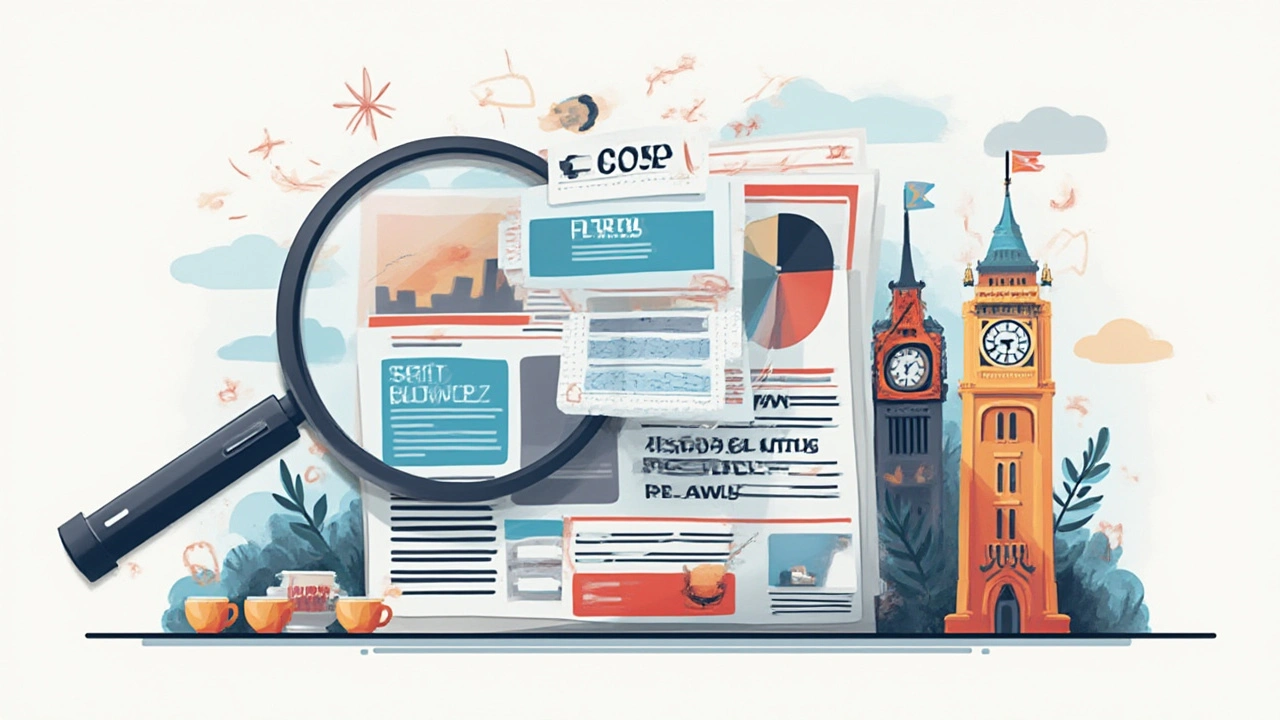
If you search for "UK news" these days, you aren’t short of choices. But where do you turn when you need the pulse of the nation, the top stories, and local colour all in one hit? That’s what makes Google News UK such a critical player. It’s like a digital front page for everything happening in Britain, from major government shakeups to football transfers that keep my son Silas glued to his phone. But Google News isn’t just about scrolling headlines; it’s shaping how we see—and trust—the news. Let’s get into what makes it tick, what you can actually do with it, and how to make it work for you instead of letting it overwhelm your day.
How Google News UK Really Works
People often imagine Google News UK as just another aggregator that blindly pulls in articles. That’s oversimplifying things. Google News uses a complex set of algorithms to scour thousands of UK news sites—from mainstream giants like BBC and The Guardian to niche regional blogs serving Liverpool, Exeter, or the Outer Hebrides. It takes into account the freshness of stories, sources’ reliability, local relevance, and even how often a story is being linked or discussed elsewhere online.
What sets Google News UK apart is this constant rebalancing act. It gives you a feed that changes by the minute. If there’s a sudden train strike announcement or emergency in Westminster, you’ll probably see it climbing up your Top Stories feed before traditional TV news even starts to script its teleprompters. And if you're curious which outlets are shaping the stream, here’s a rough snapshot showing which news sources are most frequently cited across UK headlines in 2025 (numbers reflect monthly average mentions in Google News):
| News Source | Avg. Mentions (per month) |
|---|---|
| BBC News | 18,500 |
| The Guardian | 13,100 |
| Sky News | 9,400 |
| Evening Standard | 6,300 |
| Manchester Evening News | 5,800 |
| Daily Mail | 5,200 |
The machine learning that powers Google News is constantly fine-tuned, not just by data engineers but also by events on the ground. If there’s a major weather event—floods in Yorkshire or a bizarre heatwave in Kent—Google News will spike local coverage to the top. Algorithms are trained to reduce “news fatigue” too, so you’ll notice big stories cycle down after a few hours, replaced by fresher reporting. You’ll also see curated Fact Checks, a feature that aims to flag dubious stories or viral fake news making the rounds here and abroad.
Sometimes you’ll see panel boxes called “Full Coverage.” These are Google’s attempt to give you a timeline—background stories, social media buzz, official statements, and alternatives. This matters big time if you’re trying to get a balanced take on divisive stories. The beauty (and sometimes the frustration) is you’re not just fed the loudest headline but also quieter, more detailed backgrounders. My son groans at politics but loves being able to deep-dive into Premier League drama this way.

Hidden Features and Hacks: Getting the Most from Google News UK
Most regulars just skim the home feed. But Google News UK is loaded with hidden tricks—most people don’t even scratch the surface. Want updates only from trusted local sources? Hit the ‘Local’ tab, set your region, and you’ll get stories that rarely make the national cut. This is how I keep an eye on Manchester United news without drowning in London gossip.
If alerts are driving you bonkers, you can adjust them by topic, city, or event. Maybe you only care about weather warnings or the latest NHS developments. With just a few clicks in settings, you can set Google News to ping you for health alerts but ignore celebrity fluff. Some families use these tools for school closures or COVID-19 spikes. You can even personalize the experience by blocking certain publishers or types of news altogether. Sick of endless Royal Family content? One click and it’s gone from your life—until you want it back.
Not a fan of the AI “Top Stories” picks? Flip over to “For You” or even try the “Following” tab, where you hand-select sources and topics. If you’re like me and crave control, this turns the news feed into something more useful, not just noisy. There’s also an underrated “Fact Check” feature that quietly highlights independently-verified truth from myth or politically slanted spin. This matters more than ever, especially when rapid-fire stories break—like the 2025 national rail contract dispute, where misinformation spread even faster than the trains.
If you want access on-the-go, Google News UK’s mobile app offers a couple of time-saving tricks, too. You can swipe straight to video reports—sometimes posted minutes after events happen—or set up widgets for fast access on your lock screen. Word to the wise: tweak your notifications unless you actually want 34 pings about the British weather in a single day!
For students and business users, Google News’ archive search is gold. You can jump back weeks or months to see exactly how a story developed, which is invaluable for teachers, researchers, or anyone trying to make sense of government policy shifts or financial trends. Last April, for example, I used it to fact-check claims about a new digital tax. Turns out, the rumoured changes had been debunked weeks earlier but were still being recirculated as fresh “scoops.”

What Google News UK Means for Journalism and Readers
There’s a debate raging in newsrooms across Britain—Is Google News UK a friend bringing more eyes to quality reporting, or a foe undermining paywalls and pushing clickbait to the masses? Truth is, it’s both. The platform sends millions of clicks to local and national news every week. According to a March 2025 Ofcom report, over 55% of Brits aged 16-64 say they now find breaking British news first through a Google News push notification rather than TV or radio. That’s a wild shift when you remember how we used to crowd around the telly at six o’clock.
But it also means traditional outlets have to scramble to produce eye-catching headlines and faster updates, sometimes at the cost of depth. There’s now a genuine concern about “news overload.” Google News’ own surveys show UK users spend an average of 31 minutes a day on the platform—split across browsing, searching, and sharing. It’s the go-to for people who want the story in 90 seconds, whether they’re on the Tube or waiting in the school pick-up line.
Kids, like my Silas, now expect news to be personal, interactive, and instant—if a story takes too long to load or seems too dense, it’s ignored. Google News UK lets you skip the friction. Tap for a 60-second video update, scroll for social reactions, and read in-depth if you’re still interested. That’s powerful, but it’s also easy to get stuck in a bubble. The algorithm learns what you like—be it Brexit updates, football scores, or cryptocurrency scams—and serves up more of the same. This can quietly reinforce bias if you’re not careful.
Another twist: Google News tries to surface “diverse perspectives,” marking some stories as ‘Opinion’ or ‘Analysis’ and shifting them to separate areas. The goal is to help you spot what’s fact versus commentary. Whether it works depends a lot on you—curious readers who click beyond the first two headlines are less likely to get stuck in an echo chamber. If you want to break out, spend a few minutes a week in the Topics browser or try out the ‘Full Coverage’ function regularly. It’s a quick way to sense the bigger picture.
For journalists, Google News UK can be both a lifeline and a headache. It delivers a firehose of traffic, but also makes it difficult for smaller publications to compete—unless they play nicely with Google’s publishing guidelines and agree to structured markup for articles. This has led many independent titles to invest in their own newsletters and podcasts, which often show up in Google News feeds as “features.” If you value local or independent outlets, adding them manually to your “Following” tab can help keep them in business.
One more data point: fake news and manipulated stories never sleep. Google News UK invests heavily in partnerships with fact-checkers like Full Fact, Reuters Fact Check, and BBC Reality Check. Flagged stories drop down the feed algorithmically, but it still pays to read with a critical eye. If something sounds too wild to be true, you can tap ‘Full Coverage’ for sources or hit the Fact Check label to see how claims stack up with real evidence.
If you want to keep ahead—without burning out—a few practical tips help:
- Set phone alerts only for topics or regions that really matter to you.
- Try ‘Full Coverage’ at least once a day to break algorithmic bubbles.
- Spend some time fixing your ‘Following’ list for balanced sources.
- Use Fact Check tags to steer clear of scams and political spin.
- Jump into archives when researching, not just today’s hot takes.
No single news aggregator is perfect, but Google News UK gets close when you take time to tweak it just right. Whether you want city council updates, deep dives on government policy, breaking weather alerts, or simply to impress your teen by knowing about the next football signing before their mates—this feed can give you a real edge.